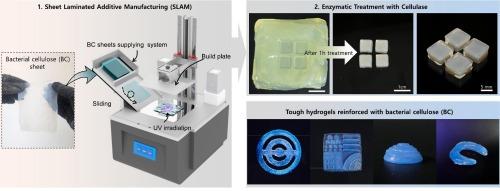Sheet-laminated additive manufacturing of bacterial cellulose nanofiber-reinforced hydrogels
IF 10.7
1区 化学
Q1 CHEMISTRY, APPLIED
引用次数: 0
Abstract
Three-dimensional (3D) printing of hydrogels offers promising potential for creating intricate, customizable structures with superior elasticity, softness, and biocompatibility. However, due to their high-water content, hydrogels often suffer from reduced mechanical strength, which is further decreased when they absorb water, limiting their use in environments requiring high mechanical durability. To address this, we developed a novel 3D printing technique to fabricate bacterial cellulose (BC) nanofiber-reinforced hydrogels, which we term sheet-laminated additive manufacturing (SLAM). SLAM is based on digital light processing (DLP) 3D printing technology and involves a process of sequentially layering BC nanofiber sheets impregnated with a photocrosslinkable monomer. The BC nanofiber sheets provide a unique 3D network, resulting in a significant enhancement of the mechanical strength of various photocrosslinkable hydrogels. A unique aspect of BC sheets is their ability to further improve mechanical properties by inducing nanofiber alignment or adjusting nanofiber density through stretching and compression pretreatments. The printed BC nanofiber-reinforced hydrogels maintained their strength after swelling and demonstrated exceptional performance in applications requiring high mechanical robustness. Our SLAM approach successfully created complex 3D structures, such as BC-reinforced hydrogel earthworm structures and pressure sensors, demonstrating its potential for advanced applications in high-stress environments.

细菌纤维素纳米纤维增强水凝胶的片状层压添加制造
水凝胶的三维(3D)打印技术为创造具有卓越弹性、柔软性和生物兼容性的复杂定制结构提供了广阔的前景。然而,由于水凝胶含水量高,其机械强度通常会降低,吸水后强度会进一步降低,从而限制了其在要求高机械耐久性的环境中的应用。为了解决这个问题,我们开发了一种新型三维打印技术来制造细菌纤维素(BC)纳米纤维增强水凝胶,我们称之为片状层压增材制造(SLAM)。SLAM以数字光处理(DLP)三维打印技术为基础,包括将浸渍了光交联单体的BC纳米纤维片按顺序分层的过程。BC纳米纤维片提供了独特的三维网络,从而显著增强了各种光交联水凝胶的机械强度。BC片材的一个独特之处在于它能够通过拉伸和压缩预处理诱导纳米纤维排列或调整纳米纤维密度,从而进一步提高机械性能。打印出的 BC 纳米纤维增强水凝胶在溶胀后仍能保持强度,在要求高机械坚固性的应用中表现出卓越的性能。我们的 SLAM 方法成功创建了复杂的三维结构,如 BC 增强水凝胶蚯蚓结构和压力传感器,证明了其在高压力环境中的先进应用潜力。
本文章由计算机程序翻译,如有差异,请以英文原文为准。
求助全文
约1分钟内获得全文
求助全文
来源期刊

Carbohydrate Polymers
化学-高分子科学
CiteScore
22.40
自引率
8.00%
发文量
1286
审稿时长
47 days
期刊介绍:
Carbohydrate Polymers stands as a prominent journal in the glycoscience field, dedicated to exploring and harnessing the potential of polysaccharides with applications spanning bioenergy, bioplastics, biomaterials, biorefining, chemistry, drug delivery, food, health, nanotechnology, packaging, paper, pharmaceuticals, medicine, oil recovery, textiles, tissue engineering, wood, and various aspects of glycoscience.
The journal emphasizes the central role of well-characterized carbohydrate polymers, highlighting their significance as the primary focus rather than a peripheral topic. Each paper must prominently feature at least one named carbohydrate polymer, evident in both citation and title, with a commitment to innovative research that advances scientific knowledge.
 求助内容:
求助内容: 应助结果提醒方式:
应助结果提醒方式:


